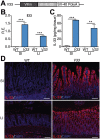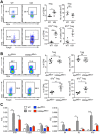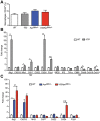Epithelial-derived IL-33 promotes intestinal tumorigenesis in Apc Min/+ mice
- PMID: 28710436
- PMCID: PMC5511216
- DOI: 10.1038/s41598-017-05716-z
Epithelial-derived IL-33 promotes intestinal tumorigenesis in Apc Min/+ mice
Abstract
Increased expression of Interleukin (IL)-33 has been detected in intestinal samples of patients with ulcerative colitis, a condition associated with increased risk for colon cancer, but its role in the development of colorectal cancer has yet to be fully examined. Here, we investigated the role of epithelial expressed IL-33 during development of intestinal tumors. IL-33 expression was detected in epithelial cells in colorectal cancer specimens and in the Apc Min/+ mice. To better understand the role of epithelial-derived IL-33 in the intestinal tumorigenesis, we generated transgenic mice expressing IL-33 in intestinal epithelial cells (V33 mice). V33 Apc Min/+ mice, resulting from the cross of V33 with Apc Min/+ mice, had increased intestinal tumor burden compared with littermate Apc Min/+ mice. Consistently, Apc Min/+ mice deficient for IL-33 receptor (ST2), had reduced polyp burden. Mechanistically, overexpression of IL-33 promoted expansion of ST2+ regulatory T cells, increased Th2 cytokine milieu, and induced alternatively activated macrophages in the gut. IL-33 promoted marked changes in the expression of antimicrobial peptides, and antibiotic treatment of V33 Apc Min/+ mice abrogated the tumor promoting-effects of IL-33 in the colon. In conclusion, elevated IL-33 signaling increases tumor development in the Apc Min/+ mice.
Conflict of interest statement
The authors declare that they have no competing interests.
Figures







References
Publication types
MeSH terms
Substances
Grants and funding
LinkOut - more resources
Full Text Sources
Other Literature Sources
Molecular Biology Databases
Research Materials

